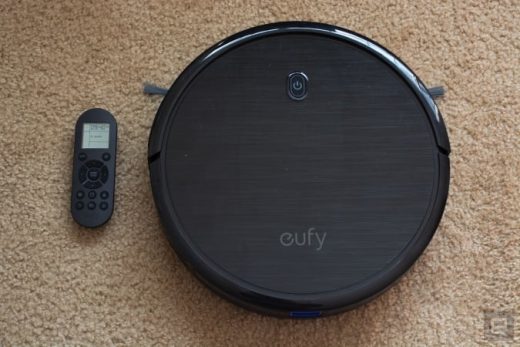The Roomba j7+ poop-detecting robot vacuum is $250 off right now
The best budget robot vacuums you can buy
Don’t spend a fortune on an autonomous dirt sucker.

We all could use a little help keeping our homes clean, and now we live in an age where robots are actually capable of lending a (mechanical) hand. Robot vacuums are some of the most recognizable smart home gadgets available today with their circular shapes and propensity for bumping into walls. While they provide an undeniable convenience, they can also have high price tags. It’s not unheard of to drop close to $1,000 on a high-end robo-vac.
But unlike just a few years ago, today there are plenty of budget robot vacuum options to choose from. At Engadget, we consider anything under $300 to be cheap in this space and you may be surprised to see how many there are at that price point. And if you’re new to the world of robot vacuums, you may find that one of these budget gadgets does everything you expected and more.
Are robot vacuums worth it?
Friends and family often ask me if new gadgets are “worth it,” and when it comes to robot vacuum the answer is yes. The most important thing they have going for them is autonomy — just turn it on, walk away. If you’re someone who wants to spend as little time as possible cleaning your home — or just someone who detests vacuuming — then a semi-autonomous robot is a great investment.
There are plenty of other good things about them that we’ll discuss in a bit, but let’s take a look at the biggest trade-offs when opting for a robot vacuum: less power, less capacity and less flexibility. The former two cons go hand in hand — robot vacuums are much smaller than upright vacuums, which leads to less suction. Also, they hold less dirt because their built-in bins are a fraction of the size of a standard vacuum canister or bag. Also, while robo-vacs are cord-free, that means they are slaves to their batteries and will require regular recharging.
When it comes to flexibility, robot vacuums do things differently than standard ones. You can control some with your smartphone, set cleaning schedules and more, but robo-vacs are primarily tasked with cleaning floors. On the flip side, their upright counterparts can come with various attachments that let you clean couches, stairs, light fixtures and other hard to reach places.
What to look for in a budget robot vacuum
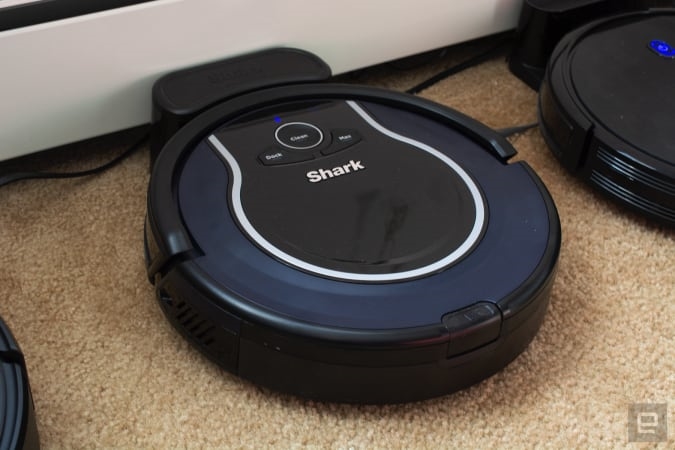
When looking for a cheap robo-vac, one of the first things you should consider is WiFi connectivity. While you may think that’s a given on all smart home devices, it’s not. Some of the most affordable robo-vacs don’t have the option to connect to your home WiFi network. If you choose one like this, you won’t be able to control it with a smartphone app or with voice commands. Another feature that’s typically reserved for WiFi-connected robots is scheduling because most of them use a mobile app to set cleaning schedules.
But WiFi-incapable vacuums usually come with remote controls that have all the basic functions that companion mobile apps do, including start, stop and return to dock. And if you’re concerned about the possibility of hacking, vacuums with no access to your WiFi network are the best option.
You should also think about the types of floors you have in your home. Are they all carpet? Or mostly hardwood and tile? Carpets demand vacuums with more suction power that can collect debris that gets pushed down into nooks and crannies. Unfortunately, there isn’t a universal metric by which suction is measured. Some companies provide Pascal (Pa) levels and generally the higher the Pa, the stronger. But other companies don’t rely on Pa levels and simply say their robots have X-times more suction than other robot vacuums.
So how can you ensure you’re getting a robot vacuum that will adequately clean your floors? Read the product description. Look for details about its ability to clean hardwood and carpets, and see if it has a “max” mode you can use to increase suction. If you are given a Pa measurement, look for around 2000Pa if you have mostly carpeted floors.
Size is also important for two reasons: clearance and dirt storage. Check the specs for the robot’s height to see if it can get underneath the furniture you have in your home. Most likely any robot vacuum you find won’t be able to clean under a couch (unless it’s a very tall, very strange couch), but some can get under entryway tables, nightstands and the like. As for dirt storage, look out for the milliliter capacity of the robot’s dustbin — the bigger the capacity, the more dirt the vacuum can collect before you have to empty it.
Object detection and cliff sensors are other key features to look out for. The former helps the robot vacuum navigate around furniture while it cleans, rather than mindlessly pushing its way into it. As for cliff sensors, these prevent robot vacuums from taking a tumble down your stairs and they are a must-have if you have a multi-level home.
The best budget robot vacuums
Best overall: $250 Shark Ion RV761
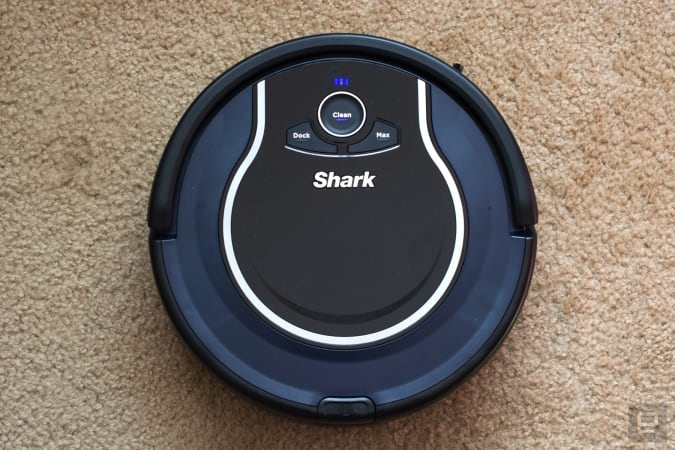
It was harder to name a best budget robot vacuum than I anticipated because many of the machines I tested were pretty solid. However, two in particular stood out a bit from the crowd: Shark’s Ion RV761 and iRobot’s Roomba 694. Shark’s device ended up besting the Roomba in a few areas: price, battery life and cleaning modes.
Buy Shark Ion RV761 at Best Buy – $259
The Shark RV761 comes in at $250 and includes two extra side brushes and one extra filter in the box. Not only is that a great price for the vacuum alone, but those included extra parts increase the amount of time you have before you have to shell out more money to keep the vacuum working properly.
Unfortunately, the robot’s design doesn’t do it any favors — it has a bowling-shirt vibe that I can’t get over. But I applaud its clearly labeled buttons, something many other robot vacuums don’t have. No obtuse icons here, just easy-to-read text for Clean, Dock and Max (the latter referring to the high-powered clean mode). You could rely just on the buttons, but it also connects to WiFi so you can use the Shark Clean app. I had no trouble connecting the Shark to my home WiFi network by following the in-app instructions, and I even got to name it before the setup was complete (Sharkey — I know, very original).
It makes as much noise as I’d expect a robot vacuum to — loud enough that I had to up the volume of the podcast I was listening to, but not loud enough for me to hear it when it was cleaning a different room down the hall. I live in a mid-sized New York apartment, so “down the hall” really isn’t all that far away. Surprisingly, switching to Max mode didn’t dramatically increase the noise level either.
The Shark doesn’t have a spot-clean feature, but Max mode is good to use when you have a specific area that needs a lot of attention. I gave Max mode a shot a few times, but I found the standard cleaning mode did a good enough job of inhaling dirt, debris, crumbs and even the cat hair embedded in my carpets. I also appreciated the Shark’s adjustable wheels, which raise and lower automatically depending on the “terrain” and the obstacles in its path. I first noticed the wheels when the Shark ran over my cat’s nearly one-inch thick toy mouse, something that most other robot vacuums just push around as they move. The mouse was unharmed, just a little squished after the encounter, and the Shark avoided sucking up any of my cat’s other toys, too (even if it did push her T-shaped play tunnel around the living room incessantly).
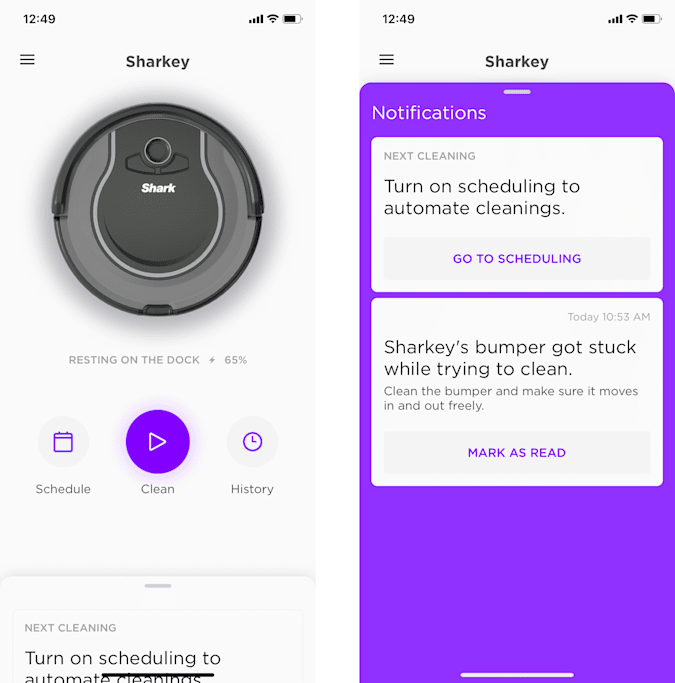
The Shark has proximity sensors like many other machines do, which help them avoid collisions. But in my experience, very few robot vacuums are actually good at doing this; they often bump into walls and furniture, readjust and move on. What sets robot vacuums apart is their ability to avoid getting stuck, or least get unstuck quickly. The Shark was just OK at this — it was tripped up by a display case that had just enough space in between its legs that the robot tried to get underneath it, but alas, failed every time.
The robot ran for an hour and a half on average in its standard cleaning mode. That’s right in line with the company’s estimated battery life, and more often than not, the Shark returned to its dock fairly quickly when it was getting low on battery. Only once did I actually have to pick up the machine and set it on its charger.
Usually, I used the Shark Clean companion app. The homepage lets you start and stop cleanings as well as switch to Max mode and “find” the robot, which just forces the machine to beep loud enough that you’ll (hopefully) hear it from across your home. You can also see how long the device has been cleaning when it’s mid-job and a full cleaning history, which is helpful to check out if you forgot the last time you ran the vacuum. In the app menu, you’ll find the scheduling feature, which lets you choose recurring days and times for regular cleanings.
Ultimately, Shark’s RV761 did everything I expected a good robot vacuum to do and did them well. For a semi-autonomous device, details like WiFi connectivity, battery life and app design can make or break your experience. While there were a few small hiccups along the way, they didn’t overshadow the fact that the Shark RV761 provides a ton of value for only $250.
Runner up: $300 iRobot Roomba 694
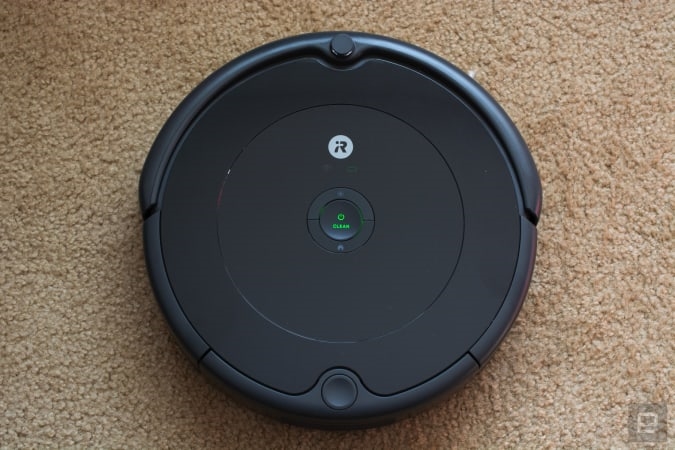
iRobot’s new Roomba 694 comes close to the Shark RV671. At $300, this model will eventually replace the Roomba 675 but, aside from an updated exterior, it’s fundamentally the same vacuum. I much prefer this robot’s all-black design to that of the Shark and it looks better than older Roomba models, too. It has three physical buttons on it — start, dock and spot — and, like the Shark, it connects to WiFi so you can control it via the iRobot app. Unfortunately, your $300 gets you the vacuum and its necessary parts only so you’ll have to pay up immediately when you need a replacement filter or brushes.
Buy Roomba 694 at Amazon – $275
Setting up the Roomba 694 is much like the Shark machine — open the companion app and follow the instructions. Once it’s connected to your home WiFi network, you’re able to use the app to control the vacuum whenever you don’t feel like using the physical buttons. However, the spot-clean function is only available as a button, which is a bit of a bummer considering I expected the app to mirror the buttons while adding even more customizable controls.
iRobot’s app is a bit better than Shark’s. Now, there’s nothing wrong with the Shark Clean app; it’s reliable and easy to use. But iRobot’s app puts most pertinent controls on the homepage, so you rarely (if ever) need to navigate through its menu to do things like set a cleaning schedule. Overall, it’s more polished than Shark’s app and that might be best for less tech-savvy people.
But simplicity can be tricky. The overall iRobot user experience is incredibly straightforward and some will prefer that over a more complicated setup. But customization and flexibility are sacrificed to achieve that. I was a bit surprised to see the features other robot vacuums have that iRobot machines don’t. Direction controls are a good example — believe it or not, most higher-end robot vacuums can’t be controlled like toy cars. But some like the Anker Eufy vacuum has them on its physical remote, and Roborock’s E4 vacuum has digital direction controls in the Mi Home app.
The Roomba 694 may not have a ton of bells and whistles, but it gets the job done and does so without you needing to tend to it. It’s on par with the Shark robot in terms of cleaning but it generally only ran for around 45 minutes before needing to dock and recharge. iRobot says run times will vary based on floor surfaces, but the 694 is estimated to have a 90-minute battery life when cleaning hard floors. Regardless, it’s more than a half hour less than Shark’s robot. While 45 minutes may be enough time for the robot to scuttle around most rooms in my apartment, those with larger homes may have to wait for it to recharge in order to clean everywhere.
iRobot has made a name for itself in the autonomous vacuum market for good reason. Its machines are polished, dead simple to use and the accompanying app is excellent. That ease of use (and the reputation of the iRobot name) comes with a slightly higher asking price, which many will be willing to pay. But there are plenty of solid options now that didn’t exist even just three years ago.
Best bang for your buck: $230 Anker Eufy RoboVac 11S
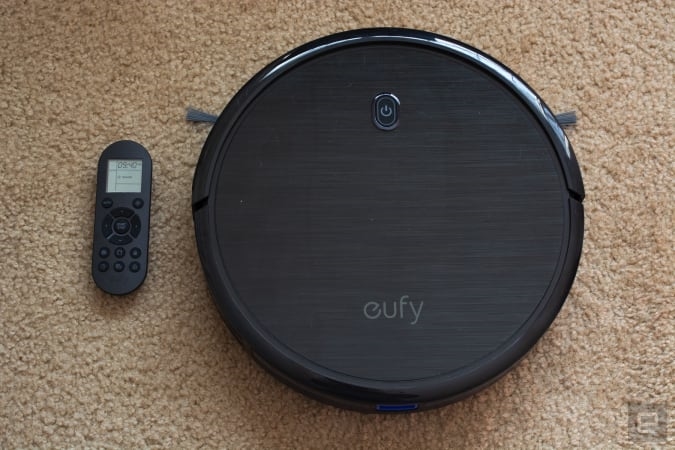
Anker’s $230 Eufy RoboVac 11S was one of the cheapest vacuums I tested but it also proved to be one of the most versatile. First thing to note: This robot vacuum doesn’t have WiFi, but it does come with a remote that gives you most of the functions you’d find in an app (including a schedule feature). Eufy also includes additional brushes and filters in the box.
Buy Eufy RoboVac 11S at Amazon – $150
The “S” in this robot’s name stands for slim, and it’s roughly half an inch thinner than all of the other vacuums I tested. Not only does this make the 11S lighter, but it was the only one that could clean under my entryway table. The 11S has a physical on-off toggle on its underside plus one button on its top that you can press to start a cleaning. It always begins in auto mode, which optimizes the cleaning process as it putters around your home, but you can use the remote to select specific modes like spot and edge clean.
I ended up repeatedly using the 11S’ spot clean feature. My partner’s main hobby involves a lot of craft supplies and usually results in tiny pieces of scrap paper all over the floor. The 11S cleaned them up well when in spot-clean mode which focuses its suction in one area as it spins outward in a spiral. I didn’t even have to pick up and move the 11S to the paper-strewn location either; the remote’s direction buttons let me drive the vacuum almost like an RC car.
The 11S has three power modes — Standard, BoostIQ and Max — and I kept mine on BoostIQ most of the time. It provided enough suction to adequately clean my carpeted floors, missing only a few crumbs or pieces of debris in corners or tight spaces around furniture. It ran for roughly one hour and 15 minutes when in BoostIQ mode and it has remarkable collision avoidance. Sure, it bumped into walls and some large pieces of furniture, but it was the only vacuum that I tried to consistently avoid hitting my cat’s play tunnel that lives in the middle of our living room floor.
As far as noise levels go, you can definitely hear the difference between BoostIQ and Max, but none of the three settings is abhorrently loud. In fact, I could barely hear the 11S when it was on the opposite end of my apartment running in BoostIQ mode. Thankfully, error alert beeps were loud enough to let me know when something went awry, like the 11S accidentally getting tripped up by a rogue charging cable (which only happened a couple of times and neither robot nor cable were harmed in the process).
Overall, the Eufy RoboVac 11S impressed me with its smarts, despite its lack of WiFi. The lack of wireless connectivity is arguably the worst thing about the robot and that’s saying a lot. It’s worth mentioning that this model is rated for up to 1300Pa suction, but you can grab the next model up, the RoboVac 11S Max, which gives you 2000Pa suction (just know that it’ll likely be louder as a result). But you can’t argue with the value of the $230 11S — especially when it’s often on sale for around $150.
(29)

